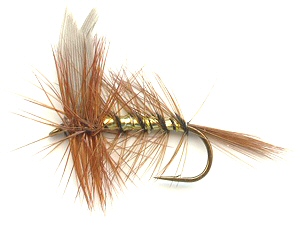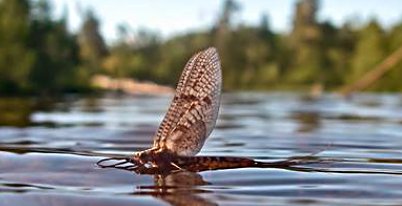The Wickham's Fancy Dry Fly
This traditional old pattern still works today. It was used when the trout are not taking artificial imitations of the natural flies. The gold ribbing acted as an attractor reflecting the sunlight and catching the fish's eye.

DRY FLY PATTERNS. Hook size 12 14 16 - $US each
Wickham's Fancy Dry Fly was originally a general purpose mayfly up-wing dry fly, designed for the chalk streams of Southern England, but it brought such good results that the color scheme has been used for single and double hooked wet flies as well as Sea trout flies. The wet fly versions is a great caddis/sedge imitation. It is best fished slow near the surface. It is believed to be designed by Dr T.C.Wickham of Winchester, Southern England in the 1880's but there has been some dispute as other Wickham's have claimed the design as theirs. Dr T.C. Wickham designed the fly originally to suggest a red spinner with wings of medium gray slate starling feather and a body of gold tinsel over brown hackle, tied in a palmer style. The Doctor was at one time connected with the Houghton Fishing Club on the river Test.
Author Courtney Williams defines a "Fancy" in his book, "Dictionary of Trout Flies", as a fly pattern which is not designed to represent any particular insect. Other authors and fly tiers have interpreted the word "Fancy" in an entirely different manner by adding it to the name of new flies that use very gaudy fly tying materials in their design. Some have gone on to use words like Terror, Killer, Wonder, Worry or Tickler to add variety. The Wickham’s Fancy has proved itself as a very useful general fly pattern.

The photograph above shows a mayfly dun on the water surface resting after just emerging before flying off. It has to wait until the blood fully pumps out its wings and they are strong and dry enough to enable it to take to the air. This is a big danger time for this insect. The trout are cruising just under the surface, looking up. As soon as they see a mayfly dun in the surface film they act because they know they do not have long before it flies off. The Wickham's Fancy Dry fly is ideal to imitate mayfly duns with this sort of colouring resting on the surface after hatching.
Wild brown trout have leant to survive in their environment over thousands of years. Their development has bred in them survival wariness. The stocked brown trout do not have the same skills. The large wild brown trout you see in the river have already survived countless encounters with bigger hungry predators. They have learnt from these near misses what to do when danger is near. If something looks un-natural flight is the best tactic. Because raised stocked fish have had a relative safe existence during their development into adulthood they do not possess the same skills. This is why wild brown trout are a fly fisherman's goal because they present a a harder challenge. In clear water a trout's camouflage may make it hard to see. Their olive green speckled back merges with the debris on the olive green river bed. To spot your next target look for the shadow they cast on the bottom. You normally spot that before you see the fish.
The main advantage fly fishermen in boats on large still waters like lakes and reservoirs, is that they can cover large areas of water in a single day and therefore search out feeding trout. A dry fly cast from the water’s edge will pick up predatory hungry rainbow and brown trout just as well as from a boat, so long as the fish are feeding within casting distance.
In the early morning and late evening trout will move into the margins of the lake to feed. During the middle of the day I have found they tend to move into the deeper more central areas. I have found the hardest time to catch trout from the bank is during the warm days of summer when the fish seek the cool deeper water. Apart from days like that, I normally set up two rods for bank fishing. One will have a floating or intermediate line and team of nymphs. The other will have a team of three dries.
Once the trout start moving during a rise I would not consider using anything other than dry fly patterns from either a boat or the bank. I was a good Scout in my youth and follow that great organisation’s motto, be prepared. I make sure I have the correct flies already tied on to match the hatch. If I am new to a water I always ask advice from the locals and read up on reports. I have often covered rising trout from the bank using only the light of the moon to spot the rise. It is a great sport.
CUSTOMER'S COMMENT
In June I went boat fishing on Bewl Water. Using a drouge we slowly drifted near the margins. It was late in the afternoon and caddis were starting to come off the water. I tied on one of your Wickhams’s Fancy Dry Flys and added some floatant. I tied on an Olive Beaded Gold Ribbed Hare’s Ear nymph on point and a partridge and yellow soft hackle wet on the middle dropper. Casting them into the ripples and letting them drift around on the breeze did the trick. I hooked into five good sized trout ranging between 1lb to 2lb. Four of the fish took the Whickham’s fancy. Its rich reddy colour combined with the gold tinsel palmered body just makes it a fantastic attractor.
- Kenneth Peterson.


Fly Fishing books

